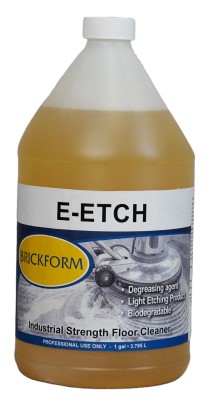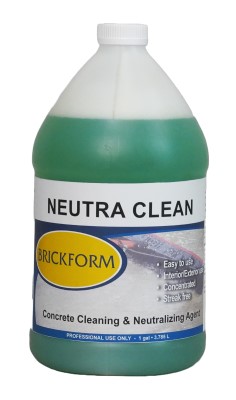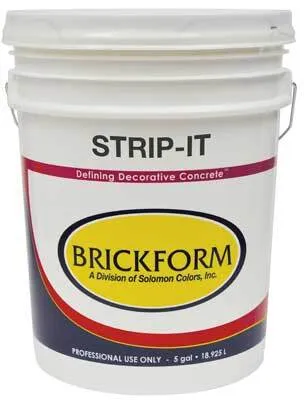Concrete Surface Preparation
What is Surface Preparation?
Surface preparation refers to the techniques used create the ideal profile on a concrete surface for the application of topical products such as sealers, coatings, overlays, and stains. Surface preparation is the most important step when installing these topical materials. A high percentage of material failure in these categories can be traced back to improper or insufficient surface preparation. If the surface is not treated correctly prior to application, materials may delaminate, they may not penetrate, or they may not bond with the substrate.
Key Surface Preparation Terms
Concrete Surface Profile – A standard of surface preparation as set by the International Concrete Repair Institute (ICRI) in their Concrete Repair Manual. Concrete Surface Profile (CSP) is approximate measure of concrete surface’s roughness and porosity. These factors determine how readily certain topical materials will bond with the concrete surface.
Bond Breakers – Any surface contamination that would prevent topical materials from adhering to or penetrating the surface of the concrete. This includes old sealer, dried adhesive, oil or grease stains, rust stains, or mildew.
Freeze-Thaw – An occurrence in which moisture inside the concrete will freeze and thaw repeatedly, causing stress on the structure of the concrete. This can lead to surface defects, weakened concrete, and topping failures. In many climates, a concrete slab may undergo this cycle thousands of times over the course of a season. Use of de-icing salts or chemicals can make this worse as well as introduce chemical contaminants.
Spalling – Cracking or delamination of the concrete surface. Volumetric expansion of material inside the concrete causes chunks and flakes of concrete to break free and cause surface defects. This is also sometimes called a “rock pop”.
See more surface preparation videos
Surface Preparation Tools
- Hammers
- Rub Stones
- Sprayers
- Brooms or Brushes
- Personal Protective Equipment
- Pressure Washer
- Rotary Floor Scrubber
- Grinders, Scarifiers, and/or Shot Blasters
- Evaluating Surface Preparation Needs
- Determine the necessary surface profile
- Examine the concrete for defects
- Check for sealer
Surface Preparation Methods
Stripping – Sealer is a bond breaker. It will also interfere with etching. Remove sealer using a stripper such as Brickform Strip-It. Remember xylene and other solvents are not strippers as they only re-emulsify the sealer. If strippers or solvents do not work, mechanical stripping is necessary. To tell if stripping is necessary, visually inspect the concrete for signs of residual sealer. Test the surface by pouring a small amount of Brickform E-Etch or muriatic acid onto the surface. If it reacts and bubbles, the surface is likely free of sealer in that spot.
Washing – Vigorous cleaning is both a mild form of surface preparation, as well as a key part of other preparation techniques. Clean the surface of the concrete using a mild, pH-neutral detergent and water. Use a power washer or rotary floor scrubber to loosen any contaminants or debris. Rinse using clean water and allow to dry. Interior surfaces may require a wet vac.
Etching – Often the lightest form of surface preparation required for stains, sealers, and microtoppings. Use diluted hydrochloric acid (often called muriatic acid) or Brickform E-Etch to remove the surface cream of the concrete and open pores. Begin by wetting the surface of the concrete. This will allow more even distribution of the etching solution and prevent burn marks. Apply E-Etch or muriatic acid dilution using an acid-resistant sprayer. Agitate etching solution with an acid-resistant broom or brush, not allowing it to dry, until the surface stops reacting. Rinse with a neutralizing solution made with Brickform Neutra Clean.
Grinding – A more aggressive form of surface preparation that uses a handheld or walk-behind grinder equipped with abrasives. This removes stubborn contaminants such as sealer, coatings, grease, and paint. Grinding also removes some of the concrete, leveling uneven surfaces and joints. Use the grinder and discs best suited for the job. Make sure the entire surface is evenly ground and fully cleaned of dust and debris. Use of dust controls is highly recommended and may be required.
Scarification – Scarifiers use multi-tipped cutting wheels or flails to remove material from the concrete surface. This is a more aggressive method than grinding, used for removing thick coatings or leveling very uneven surfaces. Scarifiers may have adjustable heads that can change depth and tool distance to achieve the desired profile. Scarification leaves a rough surface behind, so it might need to be followed up by grinding, depending on the coating or overlay used.
Shot Blasting – Shot blasting is the process of using small steel balls (also called shot) to fracture the surface of the concrete. A shot blaster propels the shot into the surface of the concrete, creating a rough, profiled surface. It collects the shot for reuse and separates out dust and debris for collection. Shot blasting is a versatile and low dust surface preparation method but it may be ineffective against some surfaces that the shot may just bounce off.
Surface Preparation Standards
CSP 1 Acid-Etch
- Antique-It
- ARTesian Stain
- Blush Tone Acid Stain
- Cem-Coat
- Micro-Topping
- SM Professional Grade
- Brickform Sealers*
CSP 2 Grinding
- ARTesian Stain
- Cem-Coat
- Micro-Topping
- SM Professional Grade
- Brickform Sealers*
CSP 3 Light Shot Blast
- Micro-Topping
- SM Professional Grade
- Stampable Overlay
CSP 4 Light Scrairication
- Stampable Overlay
CSP 5 Medium Shot Blast
- Stampable Overlay
CSP 6 Medium Scarification
CSP 7 Heavy Abrasive Blast
CSP 8 Scabbled
CSP 9 Heavy Scarification/Rotomilled
CSP 10 Handheld breaker and abrasive blasting
*Most Brickform Sealers require a CSP 1 or CSP 2. If the concrete is newly placed and free of contamination, a light cleaning and CSP 1 should be all that is needed. Older or more heavily soiled concrete requires CSP 2, especially if bond breakers are present.
For more information visit: ICRI – Concrete Repair
See More




